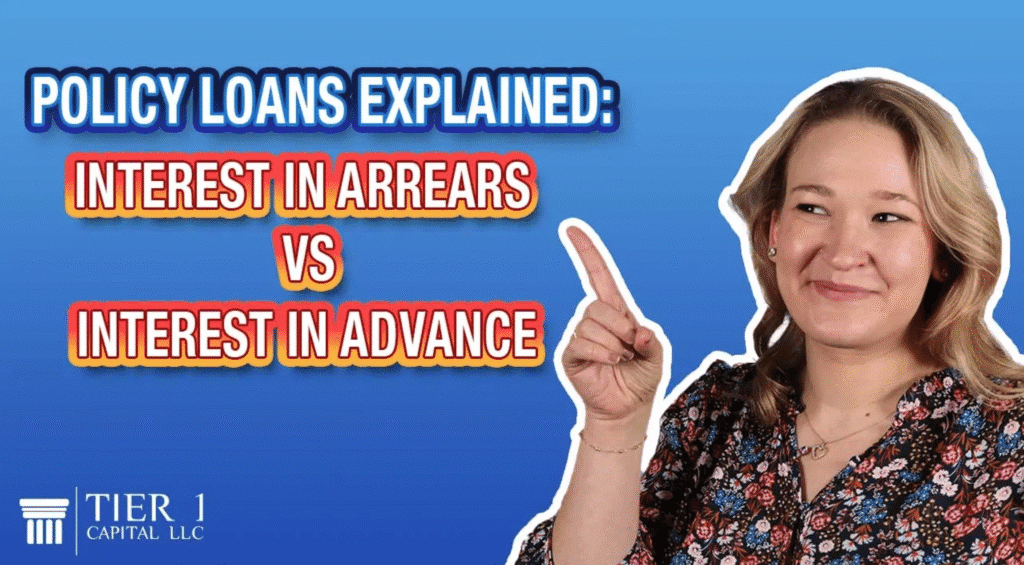
When it comes to life insurance policies, especially whole life, there are a lot of details to understand especially when it comes to policy loans. This isn’t something most people deal with every day, so naturally, it raises a lot of questions. One common question is about how interest is charged on policy loans: specifically, whether the insurance company charges interest in arrears or in advance.
Interest in arrears means the interest on your loan accrues over time and is paid at the end of the period just like how a bank typically charges interest on a mortgage. In most cases, if you take out a policy loan, you’ll receive a bill for the accumulated interest at the end of the policy year. For example, if you borrow $10,000 in the middle of the year, the insurance company will charge you interest on that balance for six months. At the end of that time, you’ll be billed for the interest let’s say at 5% annually, that would amount to $275 for six months.
This is simple interest, meaning it’s calculated straightforwardly based on the loan balance and duration. Over a full year at 5%, you’d pay $500. Over half a year, you’d owe $250 pretty straightforward.
On the other hand, some companies charge interest in advance. That means the full interest is added to your loan at the time the loan is taken. If you took the same $10,000 loan at 5% interest for six months, the company would charge $250 in interest up front. So your loan balance from day one becomes $10,250, even though you’re technically borrowing $10,000.
In the end, the total interest paid is the same either way. Whether it’s charged upfront or at the end of the year, it’s just a matter of when the interest is assessed not how much. So this common question about interest in arrears vs. advance is really a non-issue. It’s just a difference in billing timing, not in financial impact.
But what happens if you repay the loan early? Say you took the $10,000 loan and paid it off in just three months instead of six. In the case of advance interest, you’d be refunded half of what you paid upfront roughly $125 in this example since you didn’t keep the loan for the full period. So yes, even with interest in advance, early repayment can reduce the total cost.
This is often just a minor confusion people run into when searching online, but it doesn’t really affect how you use your policy loan. These are contractual guarantees, and the interest is simple and often fixed for the policy year. It’s a reliable, transparent structure, regardless of how the interest is charged.
Here’s the most important part: policy loans are unstructured loans. That means you, the policyholder, have control over how and when you pay them back. You decide whether to pay just the interest, pay down the principal, or do nothing at all so long as there’s enough cash value to cover the accumulating charges.
Of course, we always recommend paying back the interest to avoid it compounding and eating into your policy’s cash value. But if you’re in a cash flow crunch, you’re not required to pay immediately. You retain flexibility, and that’s one of the greatest benefits of using a whole life insurance policy as a financial tool.
So again, whether your interest is charged in arrears or in advance, it’s not something to stress about. What matters most is that you’re in control of your repayment schedule. That flexibility allows you to adapt based on your financial situation whether you’re flush with cash or experiencing a temporary crunch. And in times of economic uncertainty or personal financial pressure, access to liquid capital like this can make all the difference.
If you’re exploring policy loans, that’s a sign you’re thinking proactively about cash flow. And that’s a great move.
If you’d like to learn more about how to use policy loans to benefit your family, your business, or your personal situation, visit our website www.tier1capital.com and click the “Schedule Your Free Strategy Session” today. We’ll review your situation and help you understand exactly how policy loans can fit into your financial plan.
Thanks for reading, and remember it’s not how much money you make, it’s how much money you keep that really matters.
